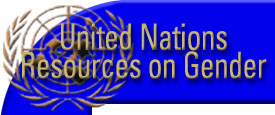

 |
|
 |
|
 |
|
 |
|
 |
|
 |
In the past 25 years - from the First World Conference on Women (1975), throughout the Decade for Women (1976 - 1985), and continuing until now - there has been a great deal of debate about what constitutes the most effective strategies and approaches for supporting gender equality. In the period since the Fourth World Conference on Women (Beijing, 1995), there has been a particular focus on two approaches: women's empowerment and gender mainstreaming. Another important area of focus has been capacity-building for institutions in order to enable them to incorporate a gender equality perspective in their work. This collection of Good Practices contains examples to illustrate each of these areas. This page provides conceptual information as well as practical examples to help users learn more about these strategies.
Women's Empowerment
Empowerment
If empowerment is the ability to exercise power, then everyday forms of women's empowerment are the ability of women to exercise power in the social institutions that govern their daily lives: the household and extended family; local community councils and associations; local elite; local markets and local government (Carr et al, 1996). Women's advocates have emphasized that empowerment cannot be done from the outside, "it is something women need to do for themselves" (Sen and Batliwala, 1997). Thus, it is misleading to assume that governments or other external agents can empower women. One aspect of empowerment is women's participation in formal political structures. This was recognized in one of the critical areas of concern in the Beijing Platform for Action, 'women in power and decision-making.' However, it seeks "to identify power less in terms of domination over others (with its implicit assumption that a gain for women implies a loss for men), and more in terms of the capacity of women to increase their own self-reliance and internal strength." As both a process and a goal, women's empowerment is fundamentally connected to democratization, human rights and the self determination of women and men. Excerpted and adapted from: DAC Sourcebook on Concepts and Approaches Linked To Gender Equality (Schalkwyk and Woroniuk, 1997) www.oecd.org/dac/htm/sourcebk.htm Women's Empowerment Revisited (Elson and Bisnath)
Gender Mainstreaming
Given the high priority granted mainstreaming strategies in the Beijing Platform for Action, it is important to understand the challenges and the benefits of this approach. Distinguishing means and ends: One way of understanding mainstreaming is to distinguish three different targets or areas for action. Support to gender mainstreaming can take place at the level of: (i) the country, e.g. through mainstreaming gender into its institutions, laws, and government policies; (ii) the development cooperation programme -- either with partner governments or multilateral organizations; and (iii) the agency itself -- its procedures and structures. Challenging the development agenda: Effective gender mainstreaming calls for a complete transformation of the development agenda, so that the participation of women as decision makers influences development priorities and activities. Specific initiatives to support equality objectives: A mainstreaming strategy does not rule out funding specific projects that empower women to work toward equality. The crucial prerequisite is that they are based on an analysis of the different situations of men and women and support gender equality.
Institutional Capacity-building Strategies
Both women's empowerment and gender mainstreaming strategies are relevant to efforts to build internal institutional capacity to support gender equality. Empowerment strategies may focus on providing leadership and skill training to ensure that women can take advantage of opportunities to rise to senior positions. Gender mainstreaming strategies may involve analyzing differential impacts of organizational policies on women staff members or ensuring that gender concerns are taken into account in programmes. It is critical to recognize, however, that no single strategy can be used to build institutional capacity to support gender equality. Often, institutional leaders might think that simply achieving parity (50/50) between women and men in decision-making positions, or having an equality policy is enough. In fact, building institutional capacity for gender equality encompasses a wide range of initiatives, involving training, review of policies and programmes, incorporating gender-accountable procedures into recruitment and performance evaluation procedures, issuing guidelines and checklists, and many other activities. Many experts in gender and organizational change (for example, Goetz (1995a) and Calás and Smircich (1996) and Rao, Stuart and Kelleher (1999)) have raised questions about how gender relations influence the very constitution of institutions and how institutions continue to produce policies and programmes that fail to recognize the needs of women. As Rao, Kelleher and Stuart (1999) assert, "gender equality can be achieved by organizations only (through)…changing inequitable power relations…" This implies a capacity-building approach that is comprehensive and attentive to both the overt (programmes and policies) and covert (culture and human relations) processes in organizations. Capacity-building strategies can include any of the following, as well as others:
|